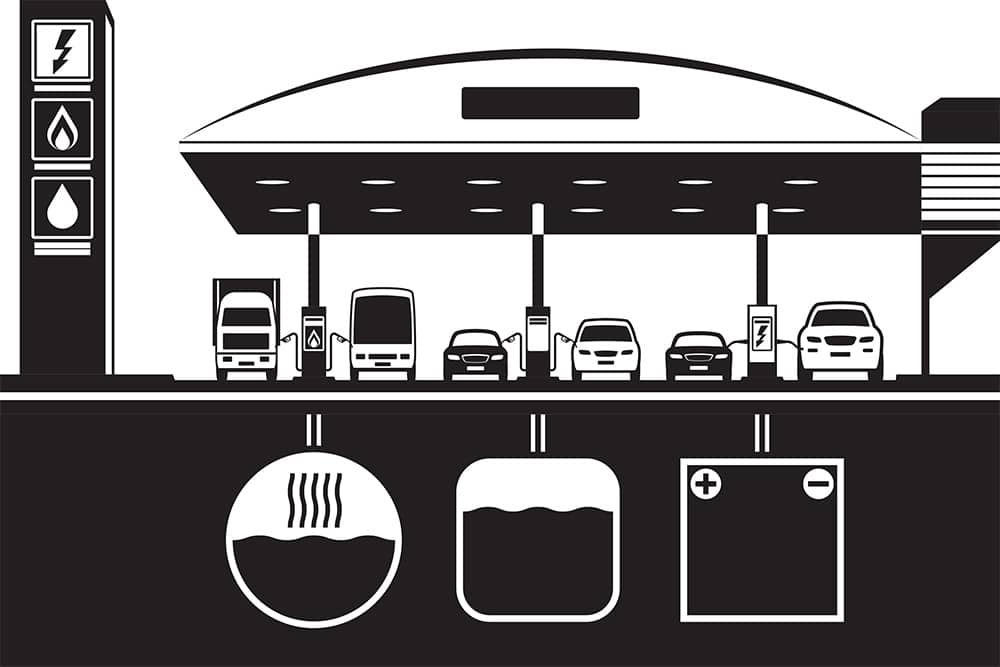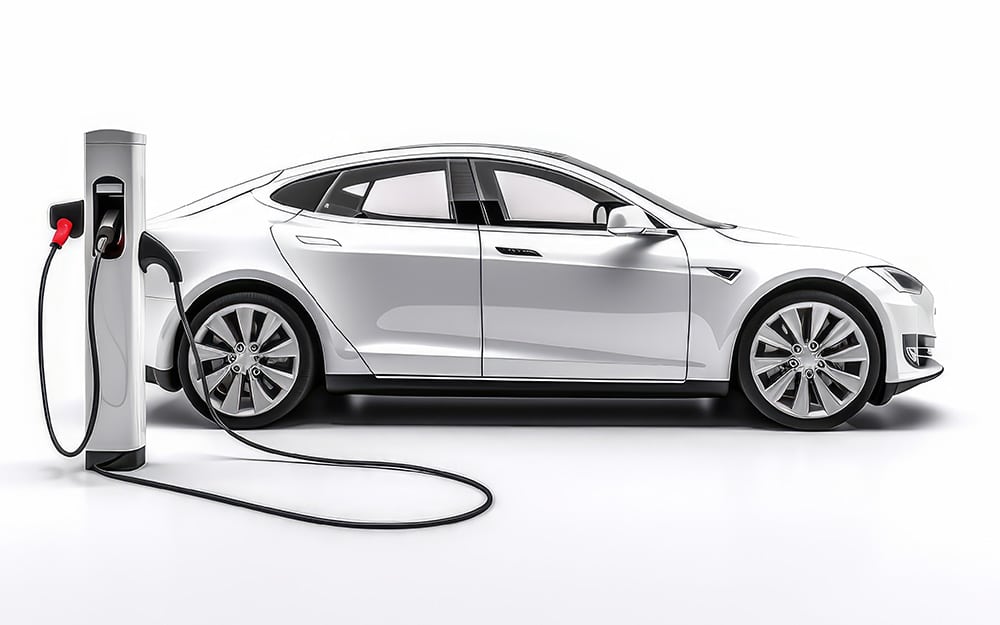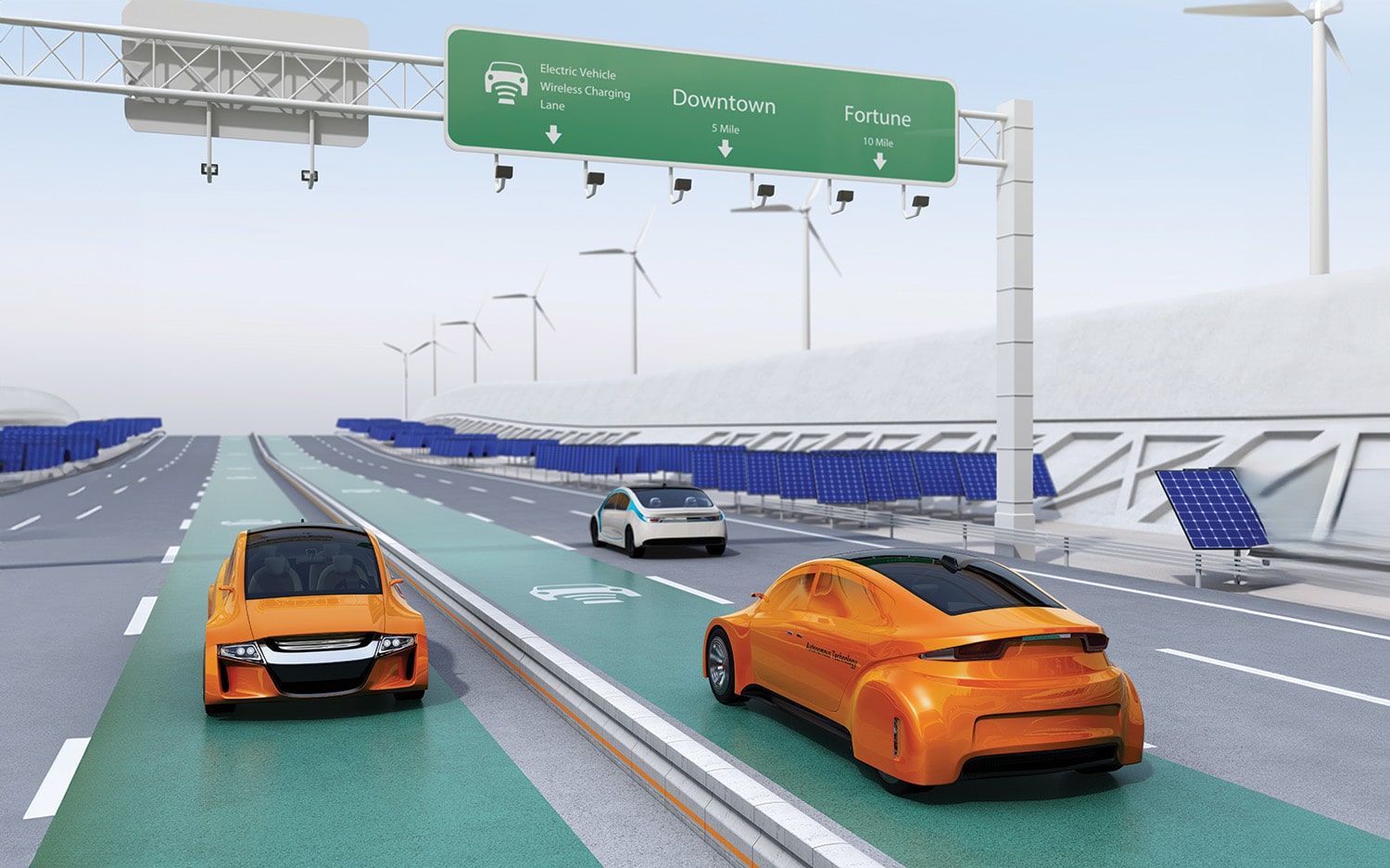
Seven-Generation Decision-Making
A major factor of sustainability is thinking about how we
Share:
Share:
Panel Recap: At the Urban Land Institute’s (ULI) 2022 Fall Meeting in Los Angeles, Ryan Gram, PE, of Kimley-Horn moderated a panel focused on the impact of EV demand, challenges, and benefits of implementing EV, emerging technology, and ways to save costs. This is a summary of that discussion.
The Biden administration aims for electric vehicles (EVs) to comprise at least half of new car sales by 2030. Similarly, S&P Global Mobility predicts that the 2030 EV market share for new vehicle sales will likely reach 40%, forecasting 28.3 million EVs on U.S. roads. With that number of active EVs, S&P Global Mobility says drivers will need 2.13 million public Level 2 chargers and 172,000 public Level 3 DC fast chargers (DCFCs).
In comparison, as of March, the U.S. had about 45,000 public Level 2 stations offering 101,000 chargers. Additionally, the U.S. had nearly 7,000 public Level 3 stations with 29,000 DCFCs, according to the Department of Energy.
These eye-opening metrics reveal that the country requires an 18-fold increase in public Level 2 and Level 3 chargers between now and 2030. From another perspective, the U.S. will need to build far more new public chargers each year until 2030 than the total number that exists today.
Government investment will fill some of the gap. The Infrastructure Investment and Jobs Act (IIJA) includes $7.5 billion to help accelerate EV adoption,
in part with a nationwide network of 500,000 EV charging stations along interstates and federal highways.
Whether along federal roadways or within cities and towns, implementing EV charging stations shows developers’ and public entities’ commitment to sustainability and response to shifting demands. Charging stations also provide a competitive edge for developments since EV owners tend to stay, spend, and buy where they can recharge.
But at the end of the day, developers need a business case to proceed with EV charging implementation. At the ULI 2022 Fall Meeting, I moderated a panel addressing this topic with three industry experts:
We discussed the impact of EV demand, the challenges and benefits of implementing EV chargers, emerging technology, revenue opportunities, and ways to save costs. I summarized five key takeaways in a January post on Kimley-Horn’s website.
This article takes a different tack, focusing on revenue and cost considerations so developers know how to make money from their EV charging investments.
Rachel Yoka of IPMI framed all parking spots—with or without EV chargers—as a form of rented space: “Parking should always be friendly, but never free.” She told the audience of developers, “It’s not free to you. It’s not free to anybody to provide, maintain, or manage. So, you’re basically renting a very small piece of real estate for a very shorter dynamic period of time.”

Different types of developments require different types of parking arrangements and different EV charging infrastructure—and therefore provide different revenue opportunities. For example, a movie theater would benefit from Level 2 charging rather than DCFC (sometimes referred to as Level 3) due to the longer customer parking time. Conversely, a convenience store would best get customer revenue with DCFC’s, where buyers could shop during a 20-minute fast charge.
Yoka said when considering EV supply equipment (EVSE), developers should have the same rental mentality they do for parking spaces and, “Charge for your charge.” She named a couple of options, including:
In addition, Kimley-Horn has worked with developers who choose a revenue-sharing model. In a typical scenario, EVSE suppliers share installation costs and share a portion of charging revenues with developers.
Other EVSE suppliers, such as Volta, generate revenue in more unique ways. Their EV chargers have media screens embedded directly into the stations, allowing them to earn money from display advertising. Volta’s Rick Baker said display media works best in a retail environment “because it creates a business value proposition” when a retailer participates in selling some of this media inventory.
Baker also emphasized retailers can profit from increased sales at their locations, which can be driven by media-enabled EV chargers placed directly beside front entrances.
Whatever the approach, as Yoka said, “If you have not yet unbundled your parking costs from your overall fee structure, you are long overdue.”

When considering EV charger deployments, developers rightly think of up-front expenses first. EVSE costs at least six figures, but a short-sighted perspective greatly inflates costs over time. To limit long-term costs, developers need to invest beyond the bare minimum.
Jennifer Deaton of utility provider Oncor said forward-thinking developers will weigh several factors at the beginning. She said, “Knowing your use case for the chargers is a great first step. Partner with your utility as early and often as you possibly can—it’s going to save you a ton of money.”
Deaton shared that school districts, for example, would likely overspend if they purchased DCFCs. Not only would they pay more for the EVSE, but they would also have higher electric bills due to the high electrical load. School buses’ scheduled operations mean that Level 2 will almost always suffice. She noted that convenience stores have a “totally different use case” because guests will stay only for 15-30 minutes, so DCFCs there justify the price.
The panelists emphasized how charger location impacts costs too. IPMI’s Yoka said, “Where to put it, I think, is the biggest question of the day. It depends on the property.” Deaton agreed, advising developers to partner with utilities to learn design requirements and varying costs of locations.
Land development costs associated with EVSE installation may include site grading, electrical engineering, and code compliance – such as for the Americans with Disabilities Act.
Utilities can also help plan for long-term total cost. Deaton said, “it’s really important to bring your entire vision to the utility up front,” even without a firm five-year plan. Deaton explained that, with an idea of developers’ charging plans, the utility can install a properly sized transformer up front rather than switching it out after a year or two.
Developers can save even more money over time by building the underlying electrical infrastructure at first and then simply adding more EV chargers above ground as EV ownership increases. When developers re-develop a structure or repave a parking lot to accommodate new EVSE, extra costs often arise. Equipment and labor may cost more, and installation activities could also trigger other work to get a building up to code. All in, this can make later rounds of EV infrastructure cost four to six times the original price.
Suppliers also greatly determine the final cost. Not only do companies’ equipment and service contracts have different price points, but they also have differing business models that translate into different cost structures. That’s why it was recommended to bring in a diversity of information from competitors to evaluate the options.
A revenue-sharing model typically means that suppliers pay for most, if not all, of the installation, maintenance, and operations costs. If the retailer owns chargers and keeps all the revenue from them, then the retailer usually pays for operations and maintenance of all EVSE equipment.
Some retailers prefer this model because the chargers enhance the guest experience. On a practical level, if a grocer’s parking lot EV chargers malfunction, customers notify the grocery store service desk, not the supplier named on the side of the charger.
But upkeep is no small task. According to J.D. Power’s Electric Vehicle Experience Public Charging Study, more than one in five charging attempts (21%) failed in the third quarter of 2022, up from 15% in the first quarter of 2021. Therefore, reliability will require more investment in the foreseeable future.
Baker emphasized the inevitability of change and growth in the EV space. He held up his smartphone during the session and asked attendees to recall the first one they owned 20 years ago.
“Imagine the first time this thing came out, and the technology enhancements just in our lifetime,” he said, forecasting similar advances in the EV market. He noted how electric vehicles have declined from $130,000 models to more affordable $30,000 options. He said that EV adoption is, “nowhere near where it’s going to be in five years and nowhere near where it’s going to be in 10 years.”
Therefore, Baker said, “a plan needs to be able to be sustainable for the next five years.” He cautioned that everyone in the industry will need to adapt their plans as new information and technology arrives. “It sounds like an overwhelming step,” he said, advising that “partnerships with people who are in the know” will be the best way to learn and profit.
To that end, IPMI’s EV Readiness Cohort will publish EV Readiness Planning resources, guidance, and best practices later this year. This collection of expertise will show the pulse of the industry and provide insights to parking, transportation, and mobility owners and operators. Follow along at IPMI’s Electric Vehicle Readiness Clearinghouse for new resources throughout 2023 and beyond. ◆
Ryan Gram, PE, is EV Charging Practice Leader for Kimley-Horn.

A major factor of sustainability is thinking about how we

Preliminary Results

Are We Ready for Wireless Charging Roads?
Parking & Mobility is IPMI’s flagship publication, covering the news, trends, analysis, technologies, and people of the parking and mobility industry, and how it affects and influences communities around the world.
| Cookie | Duration | Description |
|---|---|---|
| cookielawinfo-checkbox-advertisement | 1 year | Set by the GDPR Cookie Consent plugin, this cookie is used to record the user consent for the cookies in the "Advertisement" category . |
| cookielawinfo-checkbox-analytics | 11 months | This cookie is set by GDPR Cookie Consent plugin. The cookie is used to store the user consent for the cookies in the category "Analytics". |
| cookielawinfo-checkbox-functional | 11 months | The cookie is set by GDPR cookie consent to record the user consent for the cookies in the category "Functional". |
| cookielawinfo-checkbox-necessary | 11 months | This cookie is set by GDPR Cookie Consent plugin. The cookies is used to store the user consent for the cookies in the category "Necessary". |
| cookielawinfo-checkbox-others | 11 months | This cookie is set by GDPR Cookie Consent plugin. The cookie is used to store the user consent for the cookies in the category "Other. |
| cookielawinfo-checkbox-performance | 11 months | This cookie is set by GDPR Cookie Consent plugin. The cookie is used to store the user consent for the cookies in the category "Performance". |
| CookieLawInfoConsent | 1 year | Records the default button state of the corresponding category & the status of CCPA. It works only in coordination with the primary cookie. |
| elementor | never | This cookie is used by the website's WordPress theme. It allows the website owner to implement or change the website's content in real-time. |
| viewed_cookie_policy | 11 months | The cookie is set by the GDPR Cookie Consent plugin and is used to store whether or not user has consented to the use of cookies. It does not store any personal data. |
| Cookie | Duration | Description |
|---|---|---|
| _ga | 2 years | The _ga cookie, installed by Google Analytics, calculates visitor, session and campaign data and also keeps track of site usage for the site's analytics report. The cookie stores information anonymously and assigns a randomly generated number to recognize unique visitors. |
| _ga_02PMHW8YWC | 2 years | This cookie is installed by Google Analytics. |
| _ga_LC0QJJHM3J | 2 years | This cookie is installed by Google Analytics. |
| _ga_V9KYTSBYT2 | 2 years | This cookie is installed by Google Analytics. |
| iutk | 5 months 27 days | This cookie is used by Issuu analytic system to gather information regarding visitor activity on Issuu products. |
| Cookie | Duration | Description |
|---|---|---|
| mc | 1 year 1 month | Quantserve sets the mc cookie to anonymously track user behaviour on the website. |
| Cookie | Duration | Description |
|---|---|---|
| ultp_view_1052 | 1 day | No description |
| ultp_view_1058 | 1 day | No description |
| ultp_view_1060 | 1 day | No description |
| ultp_view_1064 | 1 day | No description |
| ultp_view_1068 | 1 day | No description |
| ultp_view_1070 | 1 day | No description |
| ultp_view_1072 | 1 day | No description |
| ultp_view_1078 | 1 day | No description |
| ultp_view_1082 | 1 day | No description |
| ultp_view_1088 | 1 day | No description |
| ultp_view_1100 | 1 day | No description |
| ultp_view_1103 | 1 day | No description |
| ultp_view_1114 | 1 day | No description |
| ultp_view_1118 | 1 day | No description |
| ultp_view_1122 | 1 day | No description |
| ultp_view_1125 | 1 day | No description |
| ultp_view_1130 | 1 day | No description |
| ultp_view_1132 | 1 day | No description |
| ultp_view_1135 | 1 day | No description |
| ultp_view_1541 | 1 day | No description |
| ultp_view_1554 | 1 day | No description |
| ultp_view_1557 | 1 day | No description |
| ultp_view_1560 | 1 day | No description |
| ultp_view_1563 | 1 day | No description |
| ultp_view_1568 | 1 day | No description |
| ultp_view_1572 | 1 day | No description |
| ultp_view_1576 | 1 day | No description |
| ultp_view_1580 | 1 day | No description |
| ultp_view_2305 | 1 day | No description |
| ultp_view_2321 | 1 day | No description |
| ultp_view_2338 | 1 day | No description |
| ultp_view_2342 | 1 day | No description |
| ultp_view_259 | 1 day | No description |
| ultp_view_270 | 1 day | No description |
| ultp_view_275 | 1 day | No description |
| ultp_view_286 | 1 day | No description |
| ultp_view_3074 | 1 day | No description |
| ultp_view_3115 | 1 day | No description |
| ultp_view_3334 | 1 day | No description |
| ultp_view_3336 | 1 day | No description |
| ultp_view_3338 | 1 day | No description |
| ultp_view_3340 | 1 day | No description |
| ultp_view_3346 | 1 day | No description |
| ultp_view_3354 | 1 day | No description |
| ultp_view_3361 | 1 day | No description |
| ultp_view_3367 | 1 day | No description |
| ultp_view_365 | 1 day | No description |
| ultp_view_367 | 1 day | No description |
| ultp_view_38 | 1 day | No description |
| ultp_view_3846 | 1 day | No description |